You know what I love? If you’ve read the title, it’s obvious: trinket text!
Trinket text is a small, usually flavorful ability (or two) that tend to be irrelevant in most games. Perhaps the best-known example of trinket text is on the original [casthaven]Baneslayer Angel[/casthaven]. You know, er, [casthaven]Baneslayer Angel[/casthaven].
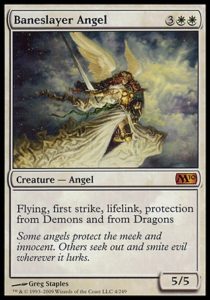
Flying, first strike, and lifelink are all powerful abilities and all are likely to be relevant. However, protection from demons and dragons not so much, making it definite trinket text. Her protection is probably most commonly useful in cube, when a player is disappointed that their [casthaven]Dragonlord Silumgar[/casthaven] can’t steal (or block) the life-gaining force of destruction, or when [casthaven]Griselbrand[/casthaven] is suddenly unable to gain any life in the face of a protected blocker.
So, what’s the excitement about? [casthaven]Baneslayer Angel[/casthaven]’s trinket text is rarely helpful, isn’t particularly flavorful (why is she, of all angels, immune to demons and dragons, anyway?) and when it is, it can just be a random annoyance for one’s opponent. Well, [casthaven]Baneslayer Angel[/casthaven] has just one kind of trinket text—mostly defensive and not particularly flavorful. Here’s a very different kind:
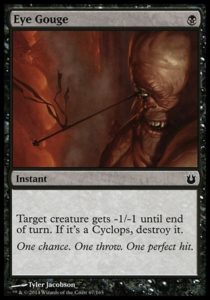
[casthaven]Eye Gouge[/casthaven] has deeply, perfectly flavorful trinket text. Poke someone in the eye? You hurt them, possibly only annoying them for a moment. But poke a cyclops in the eye? They’re done for, just like when Odysseus did it. Sure, this text isn’t going to be relevant all that often (it wasn’t even that commonly useful during Theros Limited), but when it does matter, it feels awesome. This trinket text is super flavorful, offensive, and rewarding—when it’s useful, you’re using it to power up something you’re already happy to do. In other words, this trinket text makes an underwhelming removal spell appeal to both Timmy (because it allows for some random, but exciting experiences) and Vorthos (because it’s so flavorful).
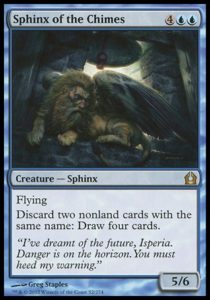
[casthaven]Sphinx of the Chimes[/casthaven] has Jenny-focused trinket text. In almost all scenarios, the sphinx is a [casthaven]Mahamoti Djinn[/casthaven]. However, it provides you with a neat little puzzle to solve, or more appropriately (but less aptly), a riddle.
In practice, this ability was almost always terrible in Limited: you were throwing away two perfectly good spells to draw probably two lands and two new spells, so there is no guarantee of you getting anything good. In order to utilize this ability in the first place, you needed to have a multiple copies of spells, something generally difficult to do in Limited unless you were jamming a bunch of bad cards in your deck (which isn’t justified by the reward), or if you’re discarding good cards you were lucky to get multiples of (which is even less likely justified by the reward). Lastly, you needed the cards you were drawing to be relevant when you were probably already winning the game by having a 5/6 flier in play.
All of this suggests that [casthaven]Sphinx of the Chimes[/casthaven]’s ability isn’t particularly good, and it’s not. Nevertheless, it’s adding some small, all-upside functionality to a card that Tammy and Spike already like plenty. In this case, trinket text is making the card relevant to a whole different class of people, by giving Johnnies a puzzle to sink their teeth into. Here, the trinket text is rewarding, but to a subset of players who wouldn’t otherwise be excited about the card.
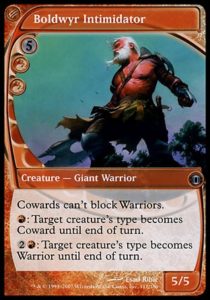
It’s easy to misunderstand what constitutes trinket text, as I’ve found from my research for this article. Trinket text is not (as I understand it) unusual text that is nevertheless central to the purpose of the card. While [casthaven]Boldwyr Intimidator[/casthaven]’s “Cowards can’t block warriors” is one of the greatest lines of text on a Magic card, it’s not trinket text: all of that card’s abilities involve using that line of text to control combat.
Also, not all trinket text is good trinket text. If you go back and look at older Magic cards, you’ll find a bunch of cards that rarely (and seemingly randomly) punished you for little apparent reason, such as [casthaven]Goblins of the Flarg[/casthaven] and[casthaven]Time Elemental[/casthaven]. When a trinket text lacks clear flavor, randomly punishes the caster, and doesn’t provide a reward, the trinket text is making the card worse, not better (as opposed to an intended downside of the card, which is an important part of balancing it).
Lastly, while trinket text can be great, it is best used sparingly. When sprinkled across a card or a few cards, it can be a reward for a particular subset of players and perhaps reward some smarter sideboarding or drafting decisions. When an entire set is laced with them, board states can become increasingly complicated as players manage swaths of text that are rarely, but potentially relevant. Moreover, players, especially new players, tend to evaluate cards based on whether they can use all parts of them. To them, [casthaven]Mahamoti Djinn[/casthaven] might be more appealing than [casthaven]Sphinx of the Chimes[/casthaven]—that’s a weird line of thought to an experienced player, since a card with tiny upside is still a strictly better card than the version lacking the upside. Nevertheless, trinket text can make cards less attractive and add unnecessary complexity.
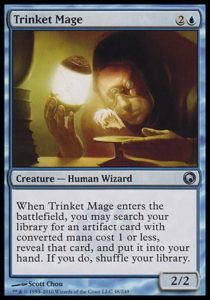
That’s all for this week. Hopefully you’ve enjoyed this delve into the littlest things in Magic.
And, as always, thanks for reading.
—Zachary Barash
Zachary Barash is a New York City-based game designer. He’s played Magic since 1994, he loves Limited and drafts every available format (including several that aren’t entirely meant to be drafted). He quite enjoys [casthaven]Revolutionary Rebuff[/casthaven], since that card demonstrates just how insanely good [casthaven]Mana Leak[/casthaven] and [casthaven]Miscalculate[/casthaven] are.

